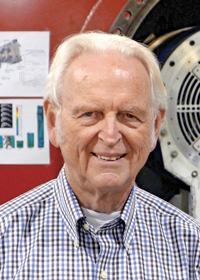 Michael G. Dunn
Michael G. Dunn
BSME ’58, MSME ’60, PhD ’61
Professor, Mechanical and Aerospace Engineering, The Ohio State University
For his significant contributions in the field of aircraft engine propulsion, controls, diagnostics, heat transfer, operability, structures and dynamics, and turbomachinery
Michael Dunn has 50-plus years' worth of fascinating stories to tell dating from NASA's early space program through defense research during the Cold War. After decades of research and development outside of academe, he has returned to mentor the next generation of engineering researchers as a professor and director of the Gas Turbine Laboratory at The Ohio State University.
Dunn's storied career began in 1961, when he took his newly earned Purdue PhD and went to work at Lockheed Missiles and Space Company. Three years later he began supporting the NASA space program at the Cornell Aeronautical Laboratory. "I worked on the space program, concentrating on the area of non-equilibrium chemistry," Dunn says. "We were responsible for determining the black-out periods during re-entry when the radio frequencies wouldn't work for a period of minutes."
That work continued during NASA's Mercury, Gemini, and Apollo missions through 1973. "After that, we got involved in two major research areas — the first with the Nuclear Defense Agency for a 19-year experimental study to determine what happens to military engines when exposed to nuclear dust or volcanic ash," he says. "That was during the Cold War years of 1976 to 1995, and the research effort is still active today. The second was with the U.S. Air Force, NASA, and U.S. industry to develop the short-duration facility for the study of time-accurate and time-averaged heat transfer and aerodynamics for full-stage, fully cooled high-pressure turbines operating at design-corrected conditions. The turbine work that started in 1976 while at Cornell Aeronautical Laboratory has continued nonstop and is still active at the OSU Gas Turbine Laboratory, some 40 years later.
Since 1995, Dunn and some of his former colleagues have benefited The Ohio State University students while making significant contributions for nearly every component of the aircraft engine, including fans, compressors, combustors and turbines, through innovations ranging from heat transfer to engine operability and control, to structural dynamics.
Dunn's distinguished career would likely not have been predicted by a casual observer — at least not at the beginning of his life. "My mother finished high school, but my dad did not," Dunn says. "He was a machinist at ComEd, the electric company. There were many people he worked with from Purdue. He insisted that both my brother and I go to college and not do what he did. So did my mom."
While finishing high school in only three years, Dunn worked in both the drafting and design, and automatic transmissions areas at the Caterpillar plant in Peoria, Illinois. "I also worked at the power plant cleaning boilers. You learn what it is you don't want to do," he says with a smile.
Opting to attend Purdue instead of Illinois — which was the larger school at the time and larger than Dunn wanted — he pursued his specific interests within engineering. "I was always more attracted to the mechanical side than the electrical side. I dabbled a lot more in the chemical side, but not Electrical Engineering or Civil. I was somewhat torn between Mechanical Engineering, Aero and Chemical."
Today, Dunn continues the work that has earned him seats on several advisory boards including the Aerospace Industries Association Volcanic Ash Committee, the National Hypersonic Test Capabilities Work Group, the Panel on Air and Ground Vehicle Technology of the Army Research Laboratory and many more. Among his 40-plus seminars, he has given seminars at the von Karman Institute Lecture Series in Brussels and at the University of Karlsruhe in Germany.
Purdue faculty and students also have benefited from Dunn's expertise. He has been a mentor to Mechanical Engineering's junior faculty in air breathing propulsion.
As for his research at The Ohio State University, Dunn says, "I've tried very hard to involve the young professors in our research, so they can carry on as if I were not here. We also have undergrads we take on when they are juniors — sometimes sophomores. You have to be unselfish, or you can never keep something like this going."
Career Highlights
| 1995-present | Professor, The Ohio State University |
|---|---|
| 1978–1995 | Research Fellow and Vice President of Research, Calspan Corporation |
| 1964–1978 | Senior Research Engineer, Cornell Aeronautical Laboratory (which became Calspan in 1972) |
| 1961–1964 | Research Engineer, Lockheed Missiles and Space Company |
| 1961 | PhD, Purdue University |
| 1960 | MSME, Purdue University |
| 1958 | BSME, Purdue University |
